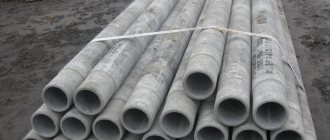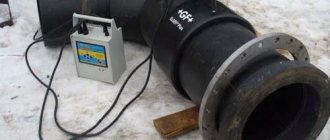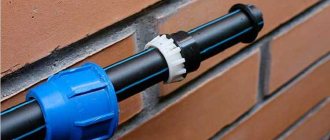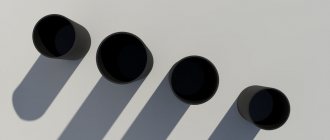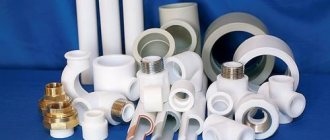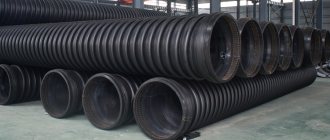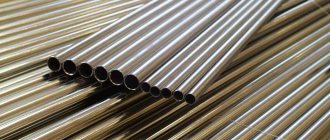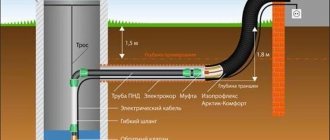Characteristics
PTFE pipes are characterized by chemical resistance and are resistant to most aggressive chemical environments - such as petroleum products, alkalis, acids, oxidizing agents and solvents.
Fluoroplastic is a dielectric, resistant to corrosion, strong and durable, resistant to shock loads, and characterized by low thermal conductivity.
PTFE pipes can be used in a wide range of temperature conditions - from minus 150 to plus 250 degrees Celsius. In addition, fluoroplastic pipes are resistant to fungi, bacteria and microorganisms.
The only thing that cannot be transported in fluoroplastic pipes is fluorine, chlorine trifluoride and molten alkali metals.
Fluoroplastic is the most slippery polymer, thanks to which liquid media do not settle on the walls of the pipes and the likelihood of clogging is minimal. It is light in weight.
The pipes are white. They are connected to each other by welding.
PTFE pipes
Pipes (bushings) made of fluoroplastic-4, fluoroplastic-4A, manufactured by extrusion.
Pipes (bushings) are made by extrusion from heat-treated granulated fluoroplastic-4 grades “O”, “T”, “PN” (GOST 10007-80), fluoroplastic-4A grades F-4A-1, F-4A-2 or F- 4A–3 (TU 6–05–1999–85).
Pipes (bushings) are intended for use as pipelines and pipeline fittings for transporting aggressive media under pressure, with the exception of molten alkali metals, chlorine trifluoride and fluorine.
The pressure of the working medium, depending on the operating temperature, is calculated using the formulas given in TU 6–05–1876–79. Pipes (bushings) are also intended for the manufacture of various parts for electrical insulation and anti-corrosion purposes.
The operating temperature range of pipes (sleeves) is from minus 200°C to plus 260°C. The guaranteed shelf life of pipes (bushings) is 20 years from the date of manufacture.
| Outer diameter, mm | Inner diameter, mm | Wall thickness, mm | Length, mm | Estimated weight of one pipe, kg | Preparation method |
| 11±0,3 | 7 | 2±0,3 | 2000 | 0,26 | Extrusion |
| 15±0,4 | 7,8 | 3,6±0,4 | 2000 | 0,60 | Extrusion |
| 15±0,4 | 11 | 2±0,3 | 2000 | 0,32 | Extrusion |
| 20±0,2 | 16 | 2±0,2 | 2000 | 0,48 | Extrusion |
| 20±0,2 | 12 | 4±0,15 | 2000 | 1,40 | Extrusion |
| 24±0,3 | 16 | 4±0,3 | 2000 | 1,10 | Extrusion |
| 25±0,3 | 21 | 2±0,5 | 2000 | 0,70 | Extrusion |
| 25±1,0 | 13 | 6±0,5 | 2000 | 1,60 | Extrusion |
| 28,0 | 18 | 5±0,7 | 2000 | 1,50 | Extrusion |
| 30±0,3 | 25 | 2,5±0,2 | 2000 | 0,92 | Extrusion |
| 30±1,5 | 20 | 5±0,5 | 2000 | 1,66 | Extrusion |
| 30±0,5 | 10 | 10±0,6 | 2000 | 2,40 | Extrusion |
| 32±0,5 | 12 | 10±0,5 | 2000 | 3,60 | Extrusion |
| 34,5±0,5 | 19,5 | 7,5±0,8 | 2000 | 2,72 | Extrusion |
| 35+1 | 11 | 12±0,5 | 2000 | 3,56 | Extrusion |
| 38±0,4 | 30 | 4±0,15 | 2000 | 1,84 | Extrusion |
| 38±0,4 | 25 | 6,5±0,5 | 2000 | 2,86 | Extrusion |
| 40±0,5 | 20 | 10±0,65 | 2000 | 4,04 | Extrusion |
| 42±0,5 | 36 | 3+3,0 | 2000 | 1,56 | Extrusion |
| 44±0,7 | 20 | 12±1,0 | 2000 | 5,18 | Extrusion |
| 44±0,7 | 10 | 13,5±0,7 | 2000 | 5,60 | Extrusion |
| 46,5±0,5 | 36,5 | 5±0,5 | 2000 | 2,80 | Extrusion |
| 46,5±0,5 | 31 | 7,5±0,8 | 2000 | 4,10 | Extrusion |
| 47±0,6 | 41 | 3±0,25 | 2000 | 1,78 | Extrusion |
| 50±0,7 | 44 | 3±0,25 | 2000 | 1,90 | Extrusion |
| 50±0,7 | 40 | 5±0,5 | 2000 | 2,82 | Extrusion |
| 50±1,0 | 20 | 15±1,0 | 2000 | 7,10 | Extrusion |
| 54±0,8 | 47 | 3,5±0,4 | 2000 | 2,20 | Extrusion |
| 54±0,8 | 44 | 5±0,5 | 2000 | 3,10 | Extrusion |
| 54±0,8 | 41 | 6,5±0,7 | 2000 | 4,20 | Extrusion |
| 56±0,7 | 50 | 3±0,3 | 2000 | 2,10 | Extrusion |
| 60±1,0 | 40 | 10±0,8 | 2000 | 6,40 | Extrusion |
| 60±1,3 | 32 | 14±1,0 | 2000 | 9,60 | Extrusion |
| 62±0,8 | 54 | 4±0,3 | 2000 | 2,80 | Extrusion |
| 66±0,8 | 58 | 4±0,3 | 2000 | 3,30 | Extrusion |
| 66±0,6 | 55 | 5,5±0,4 | 2000 | 4,50 | Extrusion |
| 66±1,0 | 51 | 7,5±0,5 | 2000 | 6,20 | Extrusion |
| 71±0,7 | 55 | 8±1,0 | 2000 | 6,50 | Extrusion |
| 72±0,8 | 60 | 6±0,5 | 2000 | 6,30 | Extrusion |
| 73±1,0 | 35 | 19±1,0 | 2000 | 14,00 | Extrusion |
| 74±1,0 | 67 | 3,5±0,3 | 2000 | 3,60 | Extrusion |
| 75±0,8 | 65 | 5±0,5 | 2000 | 4,70 | Extrusion |
| 86,5±2,0 | 66,5 | 10±1,0 | 2000 | 11,00 | Extrusion |
| 87±2,0 | 60 | 13,5±1,0 | 2000 | 13,70 | Extrusion |
| 88±1,0 | 76 | 6±0,5 | 2000 | 7,00 | Extrusion |
| 90±2,0 | 27 | 31,5±0,1 | 2000 | 24,60 | Extrusion |
| 92±1,0 | 82 | 5±0,5 | 2000 | 5,20 | Extrusion |
| 96±1,0 | 86 | 5±0,5 | 2000 | 6,14 | Extrusion |
| 96+1,4 | 82 | 7±0,5 | 2000 | 8,40 | Extrusion |
| 97±2,0 | 23 | 37±2,0 | 2000 | 30,00 | Extrusion |
| 100±2,0 | 80 | 10±2,0 | 2000 | 12,80 | Extrusion |
| 115±1,0 | 106 | 4,6±0,5 | 2000 | 6,90 | Extrusion |
| 115±2,0 | 103 | 6±0,5 | 2000 | 9,00 | Extrusion |
| 115±3,0 | 93 | 11±1,0 | 2000 | 15,60 | Extrusion |
| 123±3,0 | 105 | 9±1,0 | 2000 | 14,00 | Extrusion |
| 139±2,0 | 122 | 8,5±0,5 | 2000 | 14,40 | Extrusion |
| 145±3,0 | 135 | 5±0,5 | 2000 | 9,40 | Extrusion |
| 159±3,0 | 150 | 4,5±0,5 | 2000 | 9,60 | Extrusion |
| 190±3,0 | 177 | 6,5±0,7 | 2000 | 16,10 | Extrusion |
| 240±3,0 | 226 | 7±0,7 | 2000 | 22,00 | Extrusion |
| 290±4,0 | 276 | 7±0,7 | 2000 | 28,00 | Extrusion |
Scope of application of fluoroplastic pipes
PTFE pipes are used in the chemical, food and oil and gas industries for pumping and transporting aggressive media. Also, fluoroplastic pipes can be used as a protective material for covering shafts in industrial machines and apparatus. PTFE pipes are also used in the production of fertilizers and paper, in shipbuilding, and in the military industry.
Due to its biocompatibility, fluoroplastic pipes are also used in the pharmaceutical and medical industries. They are suitable for pumping biological media and other media that require sterile conditions.
PTFE pipes can serve as a blank for the production of rings and other parts.
Fluoroplastic pipes are highly efficient hollow round-section products made of fluoroplastic.
Features of installation of fluoroplastic pipes
The fluoroplastic pipe must be joined by socket welding. At the same time, it is heated to 365-390 degrees, depending on the diameter. As a rule, welding is carried out using an electric heater made in the form of pliers, which tightly grip the heated end of the pipe.
The fluoroplastic pipe intended for lining tees is pulled into the tee shell, then flanged onto the end flanges and the fluoroplastic flanges are clamped with special flanges to prevent leakage of the lining layer inside.
After this, a small hole is made in the pipe for the passage of the pulling screw. A cut frame is inserted into the fluoroplastic pipe, with the help of which the pipe will be pressed against the wall of the metal shell.
Advice! A fluoroplastic pipe, regardless of whether its quality control has been carried out by the manufacturer, is subject to mandatory hydraulic tests before installation. The pressure should be 1.5-2 times higher than the working pressure.
PTFE pipe connection
The connection of fluoroplastic pipes is carried out as follows:
- Thin-walled fluoroplastic blanks assembled using the socket method are placed in the working space of the heating device, and the pipes are fixed using a pneumatic clamp.
- Around the connection zone, along with the clamps, the half-rings of the external heater are also closed, and then a cylindrical frame mounted on a rod is inserted into the workpiece.
- A mandrel is also placed between the surface of the pipe and the radiating heating surface from the outside. The size of the gap between the inner and outer mandrel depends on the wall thickness of the pipeline being welded.
- Upon completion of heating of the welded zone, a time relay is switched on, counting the isothermal holding time, after which heating stops.
- After cooling and crystallization of the joint, the clamps are opened and the welded pipes are released.
Apparatus for welding fluoroplastic pipes
Upon completion of the connection, the welded fluoroplastic pipe can be fixed on fixed supports, and after hydraulic testing, the pipeline is subject to operation. So, we have looked at the features of using fluoroplastic pipes; you can learn about other types of pipes here: vinyl plastic pipes, fiberglass pipes.
Did you like the article? Subscribe to our Yandex.Zen channel
Production of fluoroplastic pipes
Fluoroplastic pipes are produced by pressing methods from powder or granules of fluoroplastic grade F-4.
The raw materials are pre-treated with gasoline or a 6% solution of polyisobutylene in gasoline. Afterwards, the raw materials are sent to an extruder, where the polymer is pressed and sintered at a temperature of 380 degrees. The compression process can be adjusted and the resulting material with different densities and porosities can be obtained.
Pipes can be produced in steel armor.
Polymer pipes
Fluoroplastic (Polytetrafluoroethylene PTFE) pipes in coils for supplying oxygen, chemically active and clean gases and liquids. They are used in microelectronics and laser technology. In the petroleum and chemical industries, in sampling laboratories.
- Catalog for stainless and polymer pipes | (6.6 MB)
Prices do not include VAT
Quick navigation:
InchMetric
Inch
| Encoding | Size | Pressure: Working/Burst | Price/m 1* | Price/m 2* | ||||||||||||||||||||||||||||||||||||||||||||||||||||||||||||||||||||||||||||||||||||||||||||||||||||||||||||||||||||||||||||||||||||||||||||||||||||||||||||||||||||||||||||||||||||||||||||||||||||||||||||||||||||||||||
| Fluoroplastic PTFE tube 1/16”; 1.59x0.4mm | 1/16"; 1.59x0.4mm | 30/120 bar | €2.10 | €2,00 | x Product information: | |||||||||||||||||||||||||||||||||||||||||||||||||||||||||||||||||||||||||||||||||||||||||||||||||||||||||||||||||||||||||||||||||||||||||||||||||||||||||||||||||||||||||||||||||||||||||||||||||||||||||||||||||||||||||
| Fluoroplastic PTFE tube 1/8”; 3.18x0.79mm | 1/8"; 3.18x0.79mm | 30/120 bar | €2.80 | €2,65 | x Product information:
|
Characteristics
PTFE pipes are characterized by chemical resistance and are resistant to most aggressive chemical environments - such as petroleum products, alkalis, acids, oxidizing agents and solvents.
Fluoroplastic is a dielectric, resistant to corrosion, strong and durable, resistant to shock loads, and characterized by low thermal conductivity.
PTFE pipes can be used in a wide range of temperature conditions - from minus 150 to plus 250 degrees Celsius. In addition, fluoroplastic pipes are resistant to fungi, bacteria and microorganisms.
The only thing that cannot be transported in fluoroplastic pipes is fluorine, chlorine trifluoride and molten alkali metals.
Fluoroplastic is the most slippery polymer, thanks to which liquid media do not settle on the walls of the pipes and the likelihood of clogging is minimal. It is light in weight.
The pipes are white. They are connected to each other by welding.
Scope of application of fluoroplastic pipe F4
F-4 pipes (F4 fluoroplastic) are intended for use as pipelines and pipeline fittings for transporting aggressive media under pressure, with the exception of molten alkali metals, chlorine trifluoride and fluorine.
The pressure of the working medium for fluoroplastic f4, depending on the operating temperature, is calculated using the formulas given in TU 6–05–1876–79.
Pipes F-4 (fluoroplastic F 4) are also intended for the manufacture of various parts for electrical insulation and anti-corrosion purposes.
The operating temperature range of F-4 pipes is from –200 °C to +260 °C.
The guaranteed shelf life of F-4 pipes is 20 years from the date of manufacture
Scope of application of fluoroplastic pipes
PTFE pipes are used in the chemical, food and oil and gas industries for pumping and transporting aggressive media. Also, fluoroplastic pipes can be used as a protective material for covering shafts in industrial machines and apparatus. PTFE pipes are also used in the production of fertilizers and paper, in shipbuilding, and in the military industry.
Due to its biocompatibility, fluoroplastic pipes are also used in the pharmaceutical and medical industries. They are suitable for pumping biological media and other media that require sterile conditions.
PTFE pipes can serve as a blank for the production of rings and other parts.
Currently, for the production of fluoroplastic pipes, the extrusion technology of “lubricated pastes” is used. This method consists of introducing a hydrocarbon lubricant into the product of emulsion polymerization of polytetrafluoroethylene - fluoroplastic F-4D, F-4DM and squeezing a tablet from the paste on a special plunger extrusion installation with various nozzles. In this way, pipes and tubes of various diameters from 0.2 mm to 600 mm and more with a wall thickness from 0.2 mm for small-diameter tubes to 6.5 for large-diameter pipes are obtained. Subsequently, the introduced lubricant is removed by drying, and the resulting product is sintered.
Thicker-walled pipes are not produced using this method due to the difficulty of drying thick-walled products and the possibility of fire when the remaining hydrocarbon lubricant sinteres. Due to the enormous shrinkage, the pipes are ellipsoidal in shape, as a result of which the pipes can only be connected by flange connection with flanged flange. For such an operation, the material must have good ductility, for which only special grades of emulsion fluoroplastic are used.
Such thin-walled pipes are used for lining steel pipes and packaged parts, manufacturing pipelines for transporting bulk products without sticking, lining chemical equipment, columns, lining the shafts of paper-making and sizing machines and machines in the food and pharmaceutical industries in order to impart anti-adhesive and anti-friction properties to products and for protection against corrosion. The production of thick-walled products using this method is impossible and is carried out by hydropressing fluoroplastic-4 powders. This method requires expensive equipment and is limited to a pressure vessel for hydropressing.
With the development at our enterprise of technology for producing fluoroplastic fibers, it has become possible to produce various products from fluoroplastic by the winding method. Products obtained by this method are distinguished by a wide variety of profiles and shapes.
It is possible to produce both thin-walled and thick-walled products with great accuracy and with a given shape, since they are sintered on mandrels. The method makes it possible to obtain products with different densities from 0.8 g/cm3 to 2.0 g/cm3. This opens up the possibility of producing porous products for filtering particularly aggressive liquids and gases in large volumes and with high productivity.
Precision tubular products can be connected using threaded connections, as well as flanges without flaring. The method makes it possible to create composite products from various heat-resistant fibers, for example, in the manufacture of sliding bearings, carbon and fluoroplastic fibers can be used, while carbon fiber provides strength, and fluoroplastic fiber provides a low coefficient of friction. The winding process is characterized by a wide variety of sizes and shapes: from rectangular and square to curved and round, using computer technology.
The process of lining shafts with fluoroplastic can be carried out directly by winding fibers onto the shafts. It is possible by winding high-strength fibers (glass, graphite, carbon) onto winding products made of fluoroplastic fibers, which in this case will act as a mandrel, to produce especially strong vessels with a bottom and pipes for aggressive liquids and gases. This method can also be used to produce large plating baths and to line the outer surfaces of various mixers when mixing aggressive liquids.
Our enterprise has mastered and introduced the production of winding pipes and cylindrical vessels with a bottom made of fluoroplastic fibers of the following standard sizes.
Table of sizes of winding filters made of fluoroplastic fiber put into production. By agreement with the Customer, other filter sizes are possible.
Winding pipes and cylindrical vessels made of fluoroplastic-4 No. Internal diameter, mm Wall thickness, mm Length/Height, mm 1552-100 up to 15002902-100 up to 150031242-100 up to 150041482-100 up to 150051582-100 up to 150061982-1 00 to 150072482-100 to 150082982-100 to 150093482-100 to 1500103982- 100 up to 1500114482-100 up to 1500124982-100 up to 1500 The cost of equipment for the customer is 15,000 rubles.
Content:
PTFE pipelines are not as widely popular as similar products made from other materials. They are mainly used in industry.
Fluoroplastic pipes
Make an order
We offer fluoroplastic pipes. Diameter 220 mm, wall thickness 15 mm, length 5 meters, price 320 RUR/kg. They have a unique combination of properties - high chemical resistance, wear resistance, resistance to shock loads, and retain properties over a wide temperature range.
PTFE pipes are used in the metallurgical and chemical industries. Pipelines made of fluoroplastic pipes are designed for transporting aggressive liquids and gases with the exception of molten alkali metals, chlorine trifluoride and elemental fluorine.
Fluoroplastic pipes in accordance with GOST 21000-81 with an internal diameter of 220 mm and a wall of 15 mm are used as an insulating screen in electric water heating boilers of the KEV-1000/10 kV type manufactured (Bratsk) for N 13518, 13514, 13517,18945, 16955, 29919 , 21532, 29917, 13516, 14451, 14448, 16957.
Pipes and shaped parts of pipelines are made of fluoroplastic-4 grades S, PN, O, T (GOST 10007-80). It is allowed to manufacture pipes and shaped parts of pipelines from fluoroplastic-4A grade F-4A-3 (TU 6-05-1999-85).
Pipes (bushings) are also intended for the manufacture of various parts for electrical insulation and anti-corrosion purposes. PTFE pipes are used as insulators for corona electrode systems in wet electrostatic precipitator systems for purifying process gases from dust, mists, resins and other substances.
1. Appearance The surface of pipes and fittings should be from white to gray, without through inclusions and cracks. The following are allowed on the outer surface of the shaped parts: - dark gray stains and rust deposits and scale from technological equipment; — presence of traces from technological equipment (roughness, spiral and annular protrusions) within the tolerance for wall thickness; - dents, scratches within the tolerance for wall thickness, the length of the allowed dents should be no more than one conventional diameter, the width should not be more than half the nominal diameter; — inclusions that do not affect the tightness of the product; — deviations from roundness (ovality) — up to 10% of the outer diameter. The following are allowed on the inner surface of pipes: the presence of traces from connectors of technological equipment (roughness); - scratches and inclusions that do not affect the tightness of the product.
2. Tightness under hydraulic pressure of 0.5 MPa (5 kgf/cm2}. The pressure of the working medium, depending on the operating temperature, is calculated using the formulas given in TU 6-05-1876-79.
3. Density, g/cm3, not less than 2.0.
4. Operating temperature range of pipes (bushings) - from minus (from -200°C to +260°C)
5. Guaranteed shelf life - 20 years from the date of manufacture.
Fluoroplastic pipes for sale, Krasnoyarsk, LLC KrasIzolit.
Call! T/f. (3912) 695-445, t. 2361115. Price from 320 rubles/kg.
| DIMENSIONS AND WEIGHTS OF PIPES | |||||
| Outer diameter, mm | Wall thickness, mm | Inner diameter, mm | Tolerance, mm | Weight 1 pc. height 100 mm, kg | |
| by outer diameter | by wall thickness | ||||
| 11 | 2 | 7 | ±0,3 | ±0,3 | 0,013 |
| 15 | 3,6 | 7,8 | ±0,4 | +0,4 | 0,030 |
| 15 | 2 | 11 | ±0,4 | ±0,3 | 0,016 |
| 20 | 2 | 16 | ±0,2 | ±0,2 | 0,024 |
| 20 | 4 | 12 | ±0,2 | ±0,15 | 0,070 |
| 24 | 4 | 16 | ±0,3 | ±0,3 | 0,055 |
| 25 | 2 | 21 | ±0,3 | ±0,5 | 0,035 |
| 25 | 6 | 13 | ±1,0 | ±0,5 | 0,080 |
| 28 | 5 | 18 | -1,0 | ±0,7 | 0,075 |
| 30 | 2,5 | 25 | ±0,3 | ±0,2 | 0,046 |
| 30 | 5 | 20 | +1,5 -0,5 | ±0,5 | 0,083 |
| 30 | 10 | 10 | ±0,5 | ±0,6 | 0,120 |
| 32 | 10 | 12 | ±0,5 | ±0,5 | 0,180 |
| 34,5 | 7,5 | 19,5 | ±0,5 | ±0,8 | 0,136 |
| 35 | 12 | 11 | +1,0 | ±0,5 | 0,178 |
| 38 | 4 | 30 | ±0,4 | ±0,15 | 0,092 |
| 38 | 6,5 | 25 | ±0,5 | ±0,5 | 0,143 |
| 40 | 10 | 20 | ±0,5 | +0,50 -0,65 | 0,202 |
| 42 | 3 | 36 | ±0,5 | +0,3 | 0,078 |
| 44 | 12 | 20 | ±0,7 | ±1,0 | 0,259 |
| 44 | 13,5 | 10 | ±0,7 | ±0,7 | 0,280 |
| 46,5 | 5 | 36,5 | ±0,5 | ±0,5 | 0,140 |
| 46,5 | 7,5 | 31 | ±0,5 | ±0,8 | 0,205 |
| 47 | 3 | 41 | ±0,6 | ±0,25 | 0,089 |
| 50 | 3 | 44 | ±0,7 | ±0,25 | 0,095 |
| 50 | 5 | 40 | ±0,7 | ±0,5 | 0,141 |
| 50 | 15 | 20 | ±1,0 | ±1,0 | 0,354 |
| 54 | 3,5 | 47 | ±0,8 | ±0,4 | 0,110 |
| 54 | 5,0 | 44 | ±0,8 | ±0,5 | 0,156 |
| 54 | 6,5 | 41 | ±0,8 | ±0,7 | 0,210 |
| 56 | 3 | 50 | ±0,7 | ±0,3 | 0,105 |
| 60 | 10 | 40 | ±1,0 | ±0,8 | 0,320 |
| 60 | 14 | 32 | +1,3 -1,0 | +1,0 -0,2 | 0,480 |
| 62 | 4 | 54 | ±0,8 | ±0,3 | 0,140 |
| 66 | 4 | 58 | ±0,8 | ±0,3 | 0,167 |
| 66 | 5,5 | 55 | ±0,6 | ±0,4 | 0,224 |
| 66 | 7,5 | 51 | ±1,0 | ±0,5 | 0,310 |
| 71 | 8 | 55 | ±0,7 | +1,0 -0,7 | 0,325 |
| 72 | 6 | 60 | ±0,8 | ±0,5 | 0,315 |
| 73 | 19 | 35 | ±1,0 | ±1,0 | 0,700 |
| 74 | 3,5 | 67 | ±1,0 | ±0,3 | 0,180 |
| 75 | 5 | 65 | ±0,8 | ±0,5 | 0,236 |
| 86,5 | 10 | 66,5 | ±2,0 | ±1,0 | 0,550 |
| 87 | 13,5 | 60 | ±2,0 | ±1,0 | 0,685 |
| 88 | 6 | 76 | ±1,0 | ±0,5 | 0,350 |
| 90 | 31,5 | 27 | ±2,0 | ±1,0 | 1,230 |
| 92 | 5 | 82 | ±1,0 | ±0,5 | 0,260 |
| 96 | 5 | 86 | ±1,0 | ±0,5 | 0,307 |
| 96 | 7 | 82 | +1,4 | ±0,5 | 0,420 |
| 97 | 37 | 23 | ±2,0 | ±2,0 | 1,500 |
| 100 | 10 | 80 | ±2,0 | ±2,0 | 0,640 |
| 115 | 4,6 | 106 | ±1,0 | ±0,5 | 0,342 |
| 115 | 6 | 103 | ±2,0 | ±0,5 | 0,450 |
| 115 | 11 | 93 | ±3,0 | ±1,0 | 0,780 |
| 123 | 9 | 105 | ±3,0 | ±1,0 | 0,70 |
| 139 | 8,5 | 122 | ±2,0 | ±0,5 | 0,720 |
| 145 | 5 | 135 | ±3,0 | ±0,5 | 0,472 |
| 159 | 4,5 | 150 | ±3,0 | ±0,5 | 0,480 |
| 190 | 6,5 | 177 | ±3,0 | ±0,7 | 0,805 |
| 240 | 7 | 226 | ±3,0 | ±0,7 | 1,100 |
| 290 | 7 | 276 | ±4,0 | ±0,7 | 1,400 |
| NOTE: Pipes are supplied in lengths from 1000 to 3000 mm. | |||||
Features of manufacturing and operation
For the production of fluoroplastic pipes, the pressing method is used, where the raw material is “fluoroplastic-4” powder (according to GOST 10007-72). PTFE pipes have a white color characteristic of most types of plastic products.
Areas of use of fluoroplastic pipes:
- Pumping of aggressive liquids. Transportation of liquids of high purity. Coating of process shafts of industrial equipment. This is done so that processed raw materials do not stick to them.
Characteristics of fluoroplastic pipes
Thanks to the chemical resistance of fluoroplastic, which is higher than that of platinum and gold, pipes made from it can safely transport the following liquids:
- Aggressive environments. High concentration alkalis. Mineral acids. Solvents. Oxidizing agents. Petroleum products.
This can apply a wide range of operating temperatures.
It is important to note the excellent strength of fluoroplastic pipelines. This makes it possible, without the threat of loss of quality, to use these products for laying both external and internal technological lines. Thick-walled fluoroplastic pipe, along with dielectric and anti-corrosion properties, perfectly withstands both very high and low temperatures (- 150 – +250 degrees). Despite their low weight, these products are characterized by some gas permeability: this imposes certain restrictions on their operation.
Design features and areas of application of fluoroplastic pipes
PTFE pipes are made by pressing from PTFE-4 powder in accordance with GOST 10007-72. The pipes have a white color characteristic of many types of plastic pipes and are used mainly for the following purposes:
- for transporting aggressive liquids;
- for transporting highly pure liquids;
- for lining the shafts of various types of technological machines in order to prevent the sticking of processed materials on the shafts.
Properties of fluoroplastic pipes
Flange connection of fluoroplastic pipes
The chemical resistance of such pipes, superior to platinum and gold in this indicator, made them possible to use when working with
- various aggressive environments,
- concentrated alkalis,
- mineral acids,
- solvents,
- oxidizing agents
- petroleum products
at a wide range of temperatures of working media.
At the same time, fluoroplastic pipes are characterized by sufficient strength for use.
Both external and internal technological communications can be laid from fluoroplastic pipes with the same degree of reliability.
A fluoroplastic pipe, in addition to its high anti-corrosion and dielectric properties, can be used at very low and fairly high temperatures - from -100 to +250 degrees.
They are lightweight, but at the same time gas-permeable, which somewhat limits their scope of application.
How to install fluoroplastic pipes
PTFE pipes are connected by welding in a socket.
The heating temperature of the material is in the range of 365-390 degrees (this is affected by the diameter size). Electrically heated tongs are usually used as a welding fixture. With their help, you can achieve a good tightness around the end of the pipe.
The fluoroplastic pipe prepared for lining the tees is clamped into the tee shell. Next, flanging is carried out on the end flanges: this is done so that the lining layer does not get inside. The dimensions of the fluoroplastic pipe must be carefully verified.
Upon completion of this procedure, a small hole is drilled in the pipe through which the tension screw will pass.
The interior of the fluoroplastic product is equipped with a cut frame that presses the pipe to the walls of the shells. It is very important to conduct hydraulic tests of a fluoroplastic pipe prepared for use. The pressure indicator should be 1.5-2 times greater than the working one.
Docking rules
In the process of joining fluoroplastic pipes, the following activities are carried out:
- Placing socket-mounted workpieces with thin walls inside the heating device. In this case, the pipes are fixed using a pneumatic clamp.
- The connecting section, in addition to the clamps, is surrounded by semicircular elements of the external heater. After this, the inside of the workpiece is filled with a cylinder-shaped frame, for fastening which a rod is used.
- The surface of the pipe and the heating base are laid along the outside with a mandrel. The dimensions of the gap between the inner and outer mandrel directly depend on the dimensions of the wall of the pipe being mounted.
- After the welding area has warmed up well, the time relay is activated: with its help, the isothermal holding time is counted. After the countdown ends, heating is completed.
- When the welded area has cooled and crystallized, you can release the clamps and pull out the joined product.
Next, the welded fluoroplastic pipe must be secured to a static stand, where it is subjected to a hydraulic test, which is mandatory before further operation of the pipeline.
